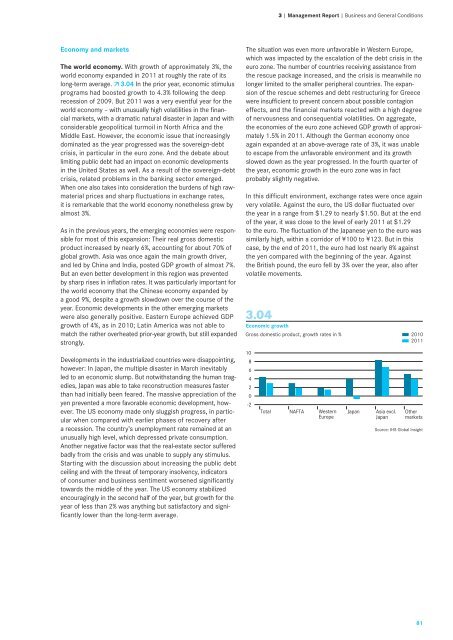Daimler Annual Report 2011 - Alle jaarverslagen
Daimler Annual Report 2011 - Alle jaarverslagen
Daimler Annual Report 2011 - Alle jaarverslagen
You also want an ePaper? Increase the reach of your titles
YUMPU automatically turns print PDFs into web optimized ePapers that Google loves.
3 | Management <strong>Report</strong> | Business and General Conditions<br />
Economy and markets<br />
The world economy. With growth of approximately 3%, the<br />
world economy expanded in <strong>2011</strong> at roughly the rate of its<br />
long-term average. 3.04 In the prior year, economic stimulus<br />
programs had boosted growth to 4.3% following the deep<br />
recession of 2009. But <strong>2011</strong> was a very eventful year for the<br />
world economy – with unusually high volatilities in the finan -<br />
cial markets, with a dramatic natural disaster in Japan and with<br />
considerable geopolitical turmoil in North Africa and the<br />
Middle East. However, the economic issue that increasingly<br />
dominated as the year progressed was the sovereign-debt<br />
crisis, in particular in the euro zone. And the debate about<br />
limiting public debt had an impact on economic developments<br />
in the United States as well. As a result of the sovereign-debt<br />
crisis, related problems in the banking sector emerged.<br />
When one also takes into consideration the burdens of high rawmaterial<br />
prices and sharp fluctuations in exchange rates,<br />
it is remarkable that the world economy nonetheless grew by<br />
almost 3%.<br />
As in the previous years, the emerging economies were responsible<br />
for most of this expansion: Their real gross domestic<br />
product increased by nearly 6%, accounting for about 70% of<br />
global growth. Asia was once again the main growth driver,<br />
and led by China and India, posted GDP growth of almost 7%.<br />
But an even better development in this region was prevented<br />
by sharp rises in inflation rates. It was particularly important for<br />
the world economy that the Chinese eco nomy expanded by<br />
a good 9%, despite a growth slowdown over the course of the<br />
year. Economic developments in the other emerging markets<br />
were also generally positive. Eastern Europe achieved GDP<br />
growth of 4%, as in 2010; Latin America was not able to<br />
match the rather overheated prior-year growth, but still expanded<br />
strongly.<br />
Developments in the industrialized countries were disappointing,<br />
however: In Japan, the multiple disaster in March inevitably<br />
led to an economic slump. But notwithstanding the human tragedies,<br />
Japan was able to take reconstruction measures faster<br />
than had initially been feared. The massive appreciation of the<br />
yen prevented a more favorable economic development, however.<br />
The US economy made only sluggish progress, in particular<br />
when compared with earlier phases of recovery after<br />
a recession. The country’s unemployment rate remained at an<br />
unusually high level, which depressed private consumption.<br />
Another negative factor was that the real-estate sector suffered<br />
badly from the crisis and was unable to supply any stimulus.<br />
Starting with the discussion about increasing the public debt<br />
ceiling and with the threat of temporary insolvency, indicators<br />
of consumer and business sentiment worsened significantly<br />
towards the middle of the year. The US economy stabilized<br />
encouragingly in the second half of the year, but growth for the<br />
year of less than 2% was anything but satisfactory and significantly<br />
lower than the long-term average.<br />
The situation was even more unfavorable in Western Europe,<br />
which was impacted by the escalation of the debt crisis in the<br />
euro zone. The number of countries receiving assistance from<br />
the rescue package increased, and the crisis is meanwhile no<br />
longer limited to the smaller peripheral countries. The expansion<br />
of the rescue schemes and debt restructuring for Greece<br />
were insufficient to prevent concern about possible contagion<br />
effects, and the financial markets reacted with a high degree<br />
of nervousness and consequential volatilities. On aggregate,<br />
the economies of the euro zone achieved GDP growth of approximately<br />
1.5% in <strong>2011</strong>. Although the German economy once<br />
again expanded at an above-average rate of 3%, it was unable<br />
to escape from the unfavorable environment and its growth<br />
slowed down as the year progressed. In the fourth quarter of<br />
the year, economic growth in the euro zone was in fact<br />
probably slightly negative.<br />
In this difficult environment, exchange rates were once again<br />
very volatile. Against the euro, the US dollar fluctuated over<br />
the year in a range from $1.29 to nearly $1.50. But at the end<br />
of the year, it was close to the level of early <strong>2011</strong> at $1.29<br />
to the euro. The fluctuation of the Japanese yen to the euro was<br />
similarly high, within a corridor of ¥100 to ¥123. But in this<br />
case, by the end of <strong>2011</strong>, the euro had lost nearly 8% against<br />
the yen compared with the beginning of the year. Against<br />
the British pound, the euro fell by 3% over the year, also after<br />
volatile movements.<br />
3.04<br />
Economic growth<br />
Gross domestic product, growth rates in % 2010<br />
<strong>2011</strong><br />
10<br />
8<br />
6<br />
4<br />
2<br />
0<br />
-2<br />
Total NAFTA Western<br />
Europe<br />
Japan<br />
Asia excl.<br />
Japan<br />
Other<br />
markets<br />
Source: IHS Global Insight<br />
81

















